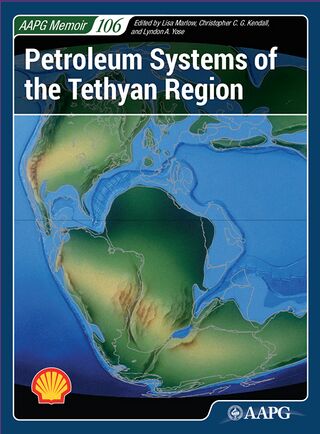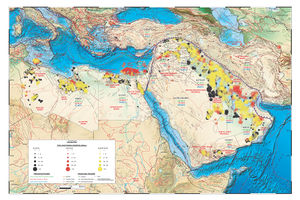Tethys region
| Petroleum systems of the Tethyan region | |

| |
| Series | AAPG Memoir |
|---|---|
| Chapter | Introduction |
| Author | Lisa Marlow, Christopher C. G. Kendall, and Lyndon A. Yose |
| Link | Web page |
| Store | AAPG Store |
The geology of the Arabian plate, North Africa and parts of Southern Eurasia are often discussed independent of one another. Our approach has been to step back and look at the region from a plate-scale geologic perspective. The present day Arabian and North Africa plates evolved together as a single unit from the Precambrian. They were physically connected as they moved around the globe from the southern polar regions to their present day position in the northern hemisphere, sub-tropical belt. Throughout the Phanerozoic, these plates have been on the margin of a series of Tethys seaways, including the Proto-Tethys, Paleo-Tethys, and Neo-Tethys. The common evolution of these plates along the Tethys Margin led to many similarities in the regional geology, including similar paleogeographic, tectonic, stratigraphic and depositional settings which, in turn, led to the development of similar petroleum systems. Though there are numerous similarities across the margin, variations occur too, and these can be compared in the chapters that follow. One primary difference across the region was the transition from uniform platform sedimentation which occurred across North Africa and Arabia, to intracontinental sub-basins and rift-basins (Arabian plate and North Africa, respectively) in the Permian, which led to “pots” of source rock across the Tethyan Margin.

| Area | Giant Fields: 500 MMboe< Recoverable Reserves (Proven+Probable) <5000 MMBOE | Supergiant Fields: Recoverable Reserves (Proven+Probable) >5000 MMBOE |
|---|---|---|
| Eastern Tethyan Margin (Countries approximately east of Dead Sea fault zone; including Syria, Jordan, Iraq, Iran, Turkey) | 194 | 47 |
| Western Tethyan Margin (Countries approximately west of Dead Sea fault zone) | 45 | 2 |
| Total Giant & Supergiant fields along Tethyan Margin | 239 | 49 |
Estimated recoverable reserves of countries along the Eastern and Western Tethyan Margins are shown in Figure 1. Many of the world’s giant and super-giant fields have been discovered in these various countries (Table 1). As shown in Table 1, these Tethyan countries account for 239 and 49 of the world’s giant and supergiant fields, respectively. There is a predominance of proven hydrocarbons on the former Eastern Tethyan Margin (Table 1). The Middle East region alone accounts for a significant amount of the global petroleum produced. The lack of giant and super-giant fields on the Western Tethyan Margin could in part be attributed to under exploration rather than less resource potential. Thus, identifying similarities across the Tethyan Margin and extrapolating known hydrocarbon systems to underexplored regions (onshore and offshore) will likely lead to more discoveries.
Paleozoic petroleum systems
During the Paleozoic, the Tethyan margin faced the Proto- and Paleo-Tethys Oceans and the paleogeography was primarily nonequitorial.[2] Paleozoic sedimentation across the margin was dominantly siliciclastic with interbedded continental, fluvial-deltaic, transitional marine deposits and intermittent carbonates.[3] Numerous proven and potential source-reservoir-seal rocks of Paleozoic age exist across the margin.[3] [4]
The most prolific and regionally extensive Paleozoic source rock, is of Silurian age. At a sub-regional scale, source rocks are reported in nearly all of the other Paleozoic intervals (in places even Precambrian).[3] [4] These regional and sub-regional proven source rocks are likely present in underexplored or undrilled areas across the entire Tethyan Margin. For example, there are proven Devonian-Carboniferous source rocks in Iraq and Turkey. The equivalent of this source rock may exist in other countries along the margin, but it is yet undocumented. Similarly, Precambrian source rocks that are responsible for most of the hydrocarbon accumulations in Oman[5] may provide new play concepts in other areas. Cambrian reservoirs are documented in Jordan[6] and Libya[7] indicating additional potential for Cambrian or older source rocks. The presence and distribution of Paleozoic reservoirs may be used to help identify other working Paleozoic petroleum systems. The Cambrian reservoir Salib in Jordon can be attributed to what possible deeper source? Likewise the Permian reservoirs in the UAE were charged from what source? Were the Permian Triassic carbonates in Southern Fars and its contiguous offshore charged by much older source rocks? Tracking reservoirs and source rocks across the margin may lead to discovery of hydrocarbons in the underexplored rocks of the Alamein Basin[8] and the Paleozoic section in northern Iraq-Kurdistan.[9]
Mesozoic/Cenozoic petroleum systems
During the Mesozoic and Cenozoic, the Tethyan Margin faced the Neo-Tethys Sea whose paleogeography was primarily equatorial.[2] At this time, sedimentation across the Tethyan Margin included dominantly shallow-marine carbonate-evaporite settings, some fluvial-deltaic systems and the advent of shallow (generally <200 meters) intra-shelf basins. Intra-shelf basins were commonly bordered by shallow-water carbonates and filled by carbonates and siliciclastics, including deposition of widespread organic rich sediments (source rocks).[3] Collectively these systems resulted in the development of world class petroleum systems that are widespread across the Tethyan Margin.[3] [4]
Jurassic and Cretaceous source rocks are important across the Tethyan Margin and account for the majority of the petroleum generated in Saudi Arabia, Iraq, Kuwait, Iran, Qatar, the United Arab Emirates, Libya and Turkey. Nearly all of the more than 137 Bbo and 106 Tcfg that occur in over 100 fields in Iraq have been generated from extremely organic-rich Jurassic and Cretaceous source rocks.[9] The organic-rich Jurassic and Cretaceous source rocks extend into Syria.[10] Jurassic source and reservoir are equally important in Saudi Arabia, where they have resulted in the world’s largest conventional oil field, Ghawar.[11] Yemen, which remains an overall frontier area, has established basins (Sab’atayn and Say’un-Masilah) with proven Jurassic and Cretaceous source rocks where recent oil discoveries were made in the Upper Jurassic-Lower Cretaceous carbonates and clastics.[12] Aptian/Albian source rocks in Iran have charged the oil in dominantly carbonate Cenomanian and Lower Miocene reservoirs in the Zagros Mountain anticlines; with these reservoirs accounting for an estimated 8% of global oil reserves.[13] In Turkey, Middle Cretaceous source rocks are probably responsible for charging the majority of the reservoirs in this country.[14] In Libya, the Campanian sedimentary section forms world class source rocks with great generative potential.[7] Upper Cretaceous source rocks have sourced 85% of Libya’s 45 Bboe reserves.[7] Egypt has multiple proven source rocks in the Mesozoic and Cenozoic sections.[8] In Lebanon, numerous shows/seeps are likely generated from Mesozoic sources,[15] while in Israel 16 oil and gas fields exist that have been sourced by dominantly Mesozoic source rocks.[16] Triassic-Jurassic-Cretaceous source rocks that exists onshore of the Eastern Mediterranean[8] [7] [15] [16] [17] [10] likely extend into the East Mediterranean-Levantine Basin.[17] [18] In the southeastern part of the Levantine Basin, the Mango well tested Lower Cretaceous sands (10,000 bo/d); these sands are likely charged from Jurassic source rocks.[8] [18]
Although Jurassic and Cretaceous source rocks are very important for the Tethyan region, there are other regionally correlative proven or potential source rocks of Triassic age.[9] [10] [8] [7] [15] [6] [11] [19] Cenozoic source rock potential also exists in some deeper basins where the source rocks may be mature.[18] Though there are many proven plays in the Mesozoic and Cenozoic across the Tethyan Margin, there are significant areas that remain undrilled. Correlating stratigraphy and hydrocarbon systems across the margin will undoubtedly facilitate the growth of new exploration ideas and new production.
Future potential and new approaches
See also
References
- ↑ Amante, C., and B. W. Eakins, ETOPO1 1 Arc-minute global relief model: Procedures, data sources and analysis: NOAA Technical Memorandum NESDIS NGDC-24, 10 p., March 2009. http://ngdc.noaa.gov/mgg/global/global.html.
- ↑ 2.0 2.1 Berra, Fabrizio, and Lucia Angiolini, 2014, The evolution of the Tethys region throughout the Phanerozoic: A brief tectonic reconstruction, in L. Marlow, C. Kendall, and L. Yose, eds., Petroleum systems of the Tethyan region: AAPG Memoir 106, p. 1-27.
- ↑ 3.0 3.1 3.2 3.3 3.4 Kendall, Christopher G. C., Abdulrahman S. Alsharhan, and Lisa Marlow, 2014, Stratigraphy and depositional systems of the southern Tethyan region, in L. Marlow, C. Kendall, and L. Yose, eds., Petroleum systems of the Tethyan region: AAPG Memoir 106, p. 29-57.
- ↑ 4.0 4.1 4.2 Ahlbrandt, Thomas S., 2014, Petroleum systems and their endowments in the Middle East and North Africa portion of the Tethys, in L. Marlow, C. Kendall, and L. Yose, eds., Petroleum systems of the Tethyan region: AAPG Memoir 106, p. 59-100.
- ↑ Droste, Henk, 2014, Petroleum geology of the Sultanate of Oman, in L. Marlow, C. Kendall, and L. Yose, eds., Petroleum systems of the Tethyan region: AAPG Memoir 106, p. 713-755.
- ↑ 6.0 6.1 Lüning, Sebastian, and Jochen Kuss, 2014, Petroleum geology of Jordan, in L. Marlow, C. Kendall, and L. Yose, eds., Petroleum systems of the Tethyan region: AAPG Memoir 106, p. 217-239.
- ↑ 7.0 7.1 7.2 7.3 7.4 Hassan, Hassan S., and Christopher C. G. Kendall, 2014, Hydrocarbon provinces of Libya: A petroleum system study, in L. Marlow, C. Kendall, and L. Yose, eds., Petroleum systems of the Tethyan region: AAPG Memoir 106, p. 101-141.
- ↑ 8.0 8.1 8.2 8.3 8.4 Dolson, John C., Mahmoud Atta, David Blanchard, Adel Sehim, Jennifer Villinski, Tom Loutit, and Karen Romine, 2014, Egypt's future petroleum resources: A revised look into the 21st Century, in L. Marlow, C. Kendall, and L. Yose, eds., Petroleum systems of the Tethyan region: AAPG Memoir 106, p. 143-178.
- ↑ 9.0 9.1 9.2 Grabowski Jr., George J., 2014, Iraq, in L. Marlow, C. Kendall, and L. Yose, eds., Petroleum systems of the Tethyan region: AAPG Memoir 106, p. 379-467.
- ↑ 10.0 10.1 10.2 Barrier, Eric, Louai Machhour, and Marc Blaizot, 2014, Petroleum systems of Syria, in L. Marlow, C. Kendall, and L. Yose, eds., Petroleum systems of the Tethyan region: AAPG Memoir 106, p. 335-378.
- ↑ 11.0 11.1 Cantrell, D. L., P. G. Nicholson, G. W. Hughes, M. A. Miller, A. G. Bhullar, S. T. Abdelbagi, and A. K. Norton, 2014, Tethyan petroleum systems of Saudi Arabia, in L. Marlow, C. Kendall, and L. Yose, eds., Petroleum systems of the Tethyan region: AAPG Memoir 106, p. 613-639.
- ↑ As-Saruri, Mustafa, and Rasoul Sorkhabi, 2014, Petroleum systems and basins of Yemen, in L. Marlow, C. Kendall, and L. Yose, eds., Petroleum systems of the Tethyan region: AAPG Memoir 106, p. 757-780.
- ↑ Derman, Ahmet Sami (A. S.), 2014, Petroleum systems of Turkish basins, in L. Marlow, C. Kendall, and L. Yose, eds., Petroleum systems of the Tethyan region: AAPG Memoir 106, p. 469-504.
- ↑ 15.0 15.1 15.2 Nader, F. H., 2014, Insights into the petroleum prospectivity of Lebanon, in L. Marlow, C. Kendall, and L. Yose, eds., Petroleum systems of the Tethyan region: AAPG Memoir 106, p. 241-278.
- ↑ 16.0 16.1 Gardosh, Michael A., and Eli Tannenbaum, 2014, The petroleum systems of Israel, in L. Marlow, C. Kendall, and L. Yose, eds., Petroleum systems of the Tethyan region: AAPG Memoir 106, p. 179-216.
- ↑ 17.0 17.1 Montadert, Lucien, Stelios Nicolaides, Per Helge Semb, and Øystein Lie, 2014, Petroleum systems offshore Cyprus, in L. Marlow, C. Kendall, and L. Yose, eds., Petroleum systems of the Tethyan region: AAPG Memoir 106, p. 301-334.
- ↑ 18.0 18.1 18.2 Marlow, Lisa, 2014, Tectonostratigraphic history and petroleum potential of the Levantine basin, eastern Mediterranean, in L. Marlow, C. Kendall, and L. Yose, eds., Petroleum systems of the Tethyan region: AAPG Memoir 106, p. 279-299.
- ↑ Alsharhan, Abdulrahman S., Christian J. Strohmenger, and Abdulla Al-Mansorri, 2014, Mesozoic petroleum systems of Abu Dhabi, United Arab Emirates, L. Marlow, C. Kendall, and L. Yose, eds., Petroleum systems of the Tethyan region: AAPG Memoir 106, p. 679-711.